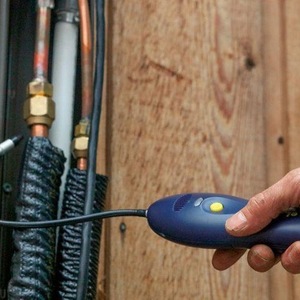
Last month, the Environmental Protection Agency (EPA) finalized regulations that will reduce the use of certain hydrofluorocarbon (HFC) refrigerants by 85% over the next 15 years. The refrigerants targeted for phasedown are potent greenhouse cases; among them is R-410A, the most widely used refrigerant in residential heat pumps and air conditioners in the U.S.
Equipment manufacturers, anticipating this transition, have begun to develop systems that use refrigerants with lower global warming potentional (GWP). Among the leading candidates to replace R-410A, approved under the EPA’s “Significant New Alternatives Policy of the Clean Air Act” (SNAP), are a group of refrigerants called A2L. Unlike R-410A and other A1 refrigerants, which can’t burn under normal conditions, A2L refrigerants are slightly flammable.
A2L refrigerants have been used in Europe and Asia for over a decade and have a good safety record. A2L systems look and perform much like R-410A systems, and most aspects of design, installation, and service are similar. But A2L systems require some additional safety features, and technicians will need training on safe work practices.
Here, I’ll give a brief history of the evolution of refrigerants leading up to the current transition. I’ll look at safety characteristics of A2L refrigerants and go into more detail on the properties of a few A2Ls likely to figure prominently as R-410A replacements. Then I’ll give a brief overview of safety considerations and present the case for rapid adoption of the new refrigerants.
A brief history of HFCs
The HFC phasedown is the fourth major refrigerant transition the HVAC industry has undergone. The earliest air conditioning systems, beginning with Willis Carrier’s pioneering invention in 1902, used ammonia, sulfur dioxide, and methyl chloride. Concerns with the toxicity and flammability of these…
Weekly Newsletter
Get building science and energy efficiency advice, plus special offers, in your inbox.

This article is only available to GBA Prime Members
Sign up for a free trial and get instant access to this article as well as GBA’s complete library of premium articles and construction details.
Start Free TrialAlready a member? Log in















5 Comments
>Customers who chose A2L systems early on may be very glad they did.
Unfortunately, it's on the manufacturers and local building authorities to make these new systems available -- unless anyone's seen something I haven't, an A2L system simply isn't an available option in the US right now. It's great that we can expect a widespread roll-out in 2024, but that doesn't help all the people like me who want to have heating systems on a timeline shorter than 3 years! It's a shame that regulatory hurdles and general resistance to change mean that we can't move ahead with these new refrigerants that have already proven their performance over many years around the world.
Great synopsis, thanks John. It’s good to hear that the transition away from r410a is underway and that industry is not mounting aggressive resistance.
Encouraging news! Does anyone know how this rule differs from the previous EPA SNAP rule to mostly-ban HFCs, which was struck down by a Federal Appellate court? By differ, I mean is it more likely to be put into effect than the previous rule?
Hi Michael, it's my understanding that the 2020 AIM Act specifically give the EPA authority to phase down HFCs. This was an authority that was not present under older laws, which is why the courts struck down previous attempts at HFC regulation in 2017.
[Edit: didn't mean this to be a reply to Michael's comment, sorry for any confusion.]
I think one of the interesting aspects of this is that it will favor monoblock or packaged systems (non-split), since they use less refrigerant, and may fall under thresholds that require ventilation systems. It will also favor air-to water systems that locate all of the refrigerant-containing systems outdoors. Those categories of systems are also more compatible with refrigerants such as CO2 that are more challenging to work with if you are running long lines, but are quite feasible to use in a factory-sealed unit.
I'm hoping that dehumidifiers and heat-pump water heaters will using R-600a. I think they are small enough that the amount used is no problem.
Log in or become a member to post a comment.
Sign up Log in